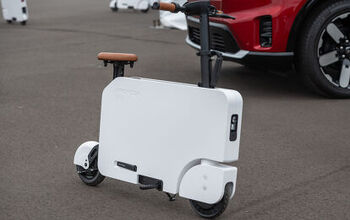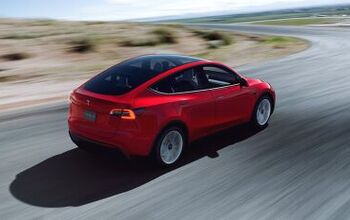Report: Future BMW I3 Will Be Less Weird Than Original

As BMW’s first mass-produced “zero emissions” vehicle, the i3 boasted a predictably quirky design that seemed to underpin most manufacturers early attempts at fielding an electric car. But the model fell short in terms of range and luxury, especially in relation to MSRP, resulting in a de facto city car for those who liked the idea of owning a BMW-badged EV.
While the vehicle implemented some novel features, the model has aged rather poorly due to advancements in battery technology. It could be argued that the i3 ended up a failure due to the fact that BMW never figured out how to produce them cheaply enough to be a volume vehicle. However, it may have also been too odd to garner true mainstream appeal — something the brand says it doesn’t want to happen for the i3’s successor.
Speaking with Germany’s Automobilwoche, BMW development boss Frank Weber admitted that the i3 was a bit of an odd duck.
"A lot of people liked it, but in the eyes of others the i3 was not a real BMW. A bit of an outsider in the classroom if you will. We will not repeat that in this form," he said.
On our market, the i3 was rarely seen beyond urban hubs. Over its nine-year production run, the little EV amassed roughly 250,000 sales globally and only about 45,000 of those landed in the United States. It was far more popular in Europe, with Germany seeing 47,500 i3 sales all by itself. But it was still a niche vehicle — too expensive to be entry-level and too humble to be a valid luxury product.
It lasted longer than many expected, with BMW ending production in August of 2022.
"BMW definitely needs to bring to market an affordable, compact car,” Weber said. "We attach great importance to offering customers the best possible access to the BMW brand. That is why we are thinking very carefully about how an entry offering can be part of the Neue Klasse family."
The brand’s “Neue Klasse” electric architecture is supposed to serve as the foundation for all subsequent EVs assembled by BMW. It’s supposed to ensure improved charging times, improved range, and reduced production costs across the lineup. However, Weber believes it will also help the company build a mainstream version of what the i3 was supposed to be.
That said, developing small and affordable vehicles doesn’t seem to be at the top of most automakers’ list of priorities right now. Despite global economic situations looking poised to toss a large portion of the planet into a subsistence mindset that would favor cheap, reliable transportation, most companies still seem to be prioritizing larger vehicles with broader profit margins.
BMW’s Neue Klasse vehicles aren’t even supposed to enter into production until 2025 and the first examples will be midsize sedans and sport utility vehicles. The i3 replacement is presumably going to manifest sometime after that.
"Within the first two years, we will then expand the Neue Klasse by four more vehicles," Weber stated. "You can easily imagine that a lot can be created from the middle downward to smaller vehicles as well as upward to larger vehicles.”
[Images: BMW]
Become a TTAC insider. Get the latest news, features, TTAC takes, and everything else that gets to the truth about cars first by subscribing to our newsletter.

A staunch consumer advocate tracking industry trends and regulation. Before joining TTAC, Matt spent a decade working for marketing and research firms based in NYC. Clients included several of the world’s largest automakers, global tire brands, and aftermarket part suppliers. Dissatisfied with the corporate world and resentful of having to wear suits everyday, he pivoted to writing about cars. Since then, that man has become an ardent supporter of the right-to-repair movement, been interviewed on the auto industry by national radio broadcasts, driven more rental cars than anyone ever should, participated in amateur rallying events, and received the requisite minimum training as sanctioned by the SCCA. Handy with a wrench, Matt grew up surrounded by Detroit auto workers and managed to get a pizza delivery job before he was legally eligible. He later found himself driving box trucks through Manhattan, guaranteeing future sympathy for actual truckers. He continues to conduct research pertaining to the automotive sector as an independent contractor and has since moved back to his native Michigan, closer to where the cars are born. A contrarian, Matt claims to prefer understeer — stating that front and all-wheel drive vehicles cater best to his driving style.
More by Matt Posky
Latest Car Reviews
Read moreLatest Product Reviews
Read moreRecent Comments
- Peter Buying an EV from Toyota is like buying a Bible from Donald Trump. Don’t be surprised if some very important parts are left out.
- Sheila I have a 2016 Kia Sorento that just threw a rod out of the engine case. Filed a claim for new engine and was denied…..due to a loop hole that was included in the Class Action Engine Settlement so Hyundai and Kia would be able to deny a large percentage of cars with prematurely failed engines. It’s called the KSDS Improvement Campaign. Ever hear of such a thing? It’s not even a Recall, although they know these engines are very dangerous. As unknowing consumers load themselves and kids in them everyday. Are their any new Class Action Lawsuits that anyone knows of?
- Alan Well, it will take 30 years to fix Nissan up after the Renault Alliance reduced Nissan to a paltry mess.I think Nissan will eventually improve.
- Alan This will be overpriced for what it offers.I think the "Western" auto manufacturers rip off the consumer with the Thai and Chinese made vehicles.A Chinese made Model 3 in Australia is over $70k AUD(for 1995 $45k USD) which is far more expensive than a similar Chinesium EV of equal or better quality and loaded with goodies.Chinese pickups are $20k to $30k cheaper than Thai built pickups from Ford and the Japanese brands. Who's ripping who off?
- Alan Years ago Jack Baruth held a "competition" for a piece from the B&B on the oddest pickup story (or something like that). I think 5 people were awarded the prizes.I never received mine, something about being in Australia. If TTAC is global how do you offer prizes to those overseas or are we omitted on the sly from competing?In the end I lost significant respect for Baruth.






































Comments
Join the conversation
Had an i3 REX years ago for a weekend when BMW couldn't give these things away. No way would I go for the rex version as you could smell gas in the car. What were they thinking???? Also, the e-range was effectively 55-65 miles. This is an errand car ONLY. I did hear that later versions came with bigger batteries for 100-120 miles/range.
I still drive a BEV 2018 i3 every day. The key is I bought it used, so I paid about half what the original owner did. It's an amazing city car, and the limited range (about 120 miles in city driving) isn't really an issue for my day-to-day routine (school drop-off, shopping, commute). The best part is that it costs a shockingly small amount to operate.
With rear wheel drive and good acceleration, great visibility, and a 32.6-foot turning radius, there are few cars that are as well suited and fun for city driving.
I think the lack of affordable small EVs in the US is a real shame. They fit urban and close-in suburban living well. And second Pickles69's desire to see a hatchback successor. I really want the utility without having to drive some enormous boat of a vehicle.